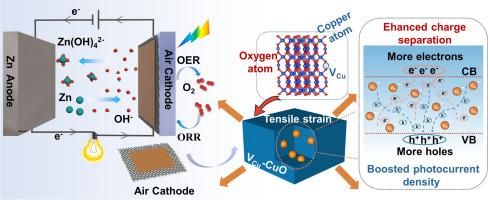Copper vacancies-driven tensile lattice strain accelerates oxygen reduction in photo-assisted Zn-air batteries cathodes
IF 8.3
1区 材料科学
Q1 MATERIALS SCIENCE, MULTIDISCIPLINARY
引用次数: 0
Abstract
Recently, photo-assisted Zn-air batteries (ZABs) have been confirmed to accelerate the kinetics of oxygen reduction reaction (ORR); however, challenges such as rapid charge carrier recombination and low light utilization efficiency still remain. Herein, lattice-distorted copper oxide was constructed by copper vacancies (CuO-0.9%VCu). Approximate 0.9% deficiency of Cu2+ (t2g6eg3) creats 2.16% tensile strain through the Jahn-Teller effect. This tensile strain allows strong chemisorption and activation of *OOH intermediates on active Cu atoms due to the upshift of d-band center, thus prompting fast O2 reduction rate. Additionally, copper vacancies can act as hole traps to inhibit rapid electron-hole recombination, enabling the CuO-0.9%VCu photocathode to achieve a charge separation yield of 59% and a transfer yield of 70% in ORR reactions. Therefore, ZABs using CuO-0.9%VCu as photocathodes deliver a remarkable discharge voltage of 1.36 V, a high energy efficiency of 70.47%, and a cyclic durability of surpassing 100 h under 1-sun illumination. CuO-0.9%VCu provides a typical case for the usage of clean and readily available light energy, as well as offers a typical case to realize simultaneously harvesting, converting and storing of solar energy.

求助全文
约1分钟内获得全文
求助全文
来源期刊

Acta Materialia
工程技术-材料科学:综合
CiteScore
16.10
自引率
8.50%
发文量
801
审稿时长
53 days
期刊介绍:
Acta Materialia serves as a platform for publishing full-length, original papers and commissioned overviews that contribute to a profound understanding of the correlation between the processing, structure, and properties of inorganic materials. The journal seeks papers with high impact potential or those that significantly propel the field forward. The scope includes the atomic and molecular arrangements, chemical and electronic structures, and microstructure of materials, focusing on their mechanical or functional behavior across all length scales, including nanostructures.
 求助内容:
求助内容: 应助结果提醒方式:
应助结果提醒方式:


